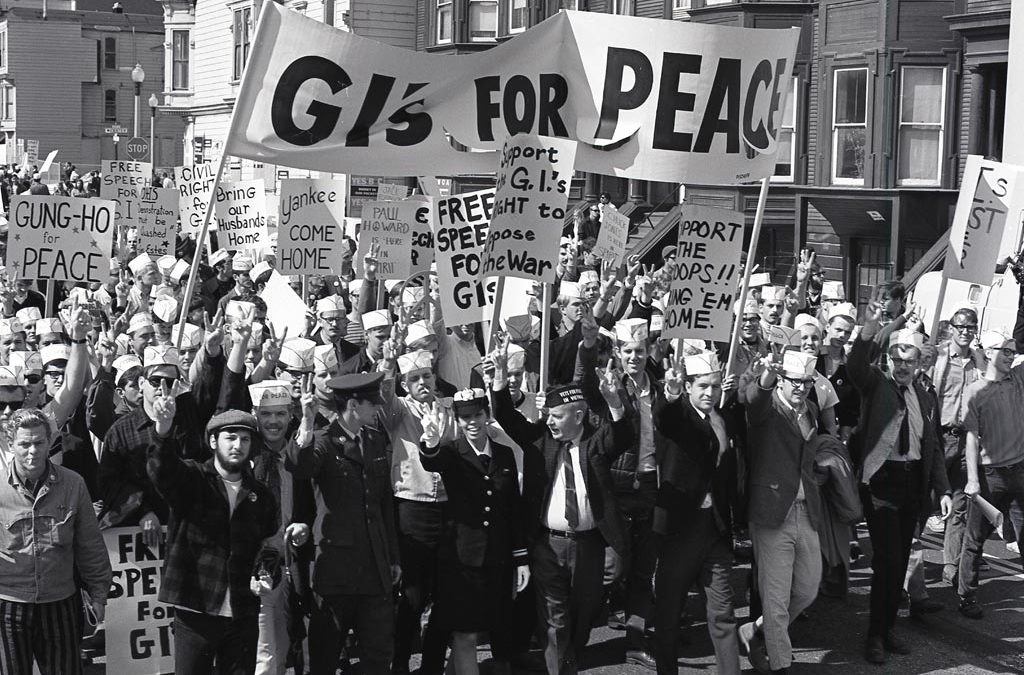The ignominies of the U.S. war in Vietnam are well known, as recounted in Chuck Searcy’s essay. Less well known is the rebellion in the ranks known as “the GI Movement,” which David Cortright discusses in his article. Active duty servicepersons circulated dissident newspapers at military bases, refused to engage in combat, and rejected orders to deploy. Some of these rebels formed a highly-organized movement, while others acted more spontaneously. Taken together, the various forms of soldier rebellion contested the war and institutionalized racism and crippled the U.S. government’s efforts to keep boots on the ground.
While the scope and scale of rebellion during Vietnam was tremendous, it is not wholly unique. As economist and political theorist Albert Hirschman[1] argues, soldiers may choose “voice” or “exit” over “loyalty” when aggrieved with their commanders. Forms of “exit,” such as draft-dodging, conscientious objection, and going AWOL, occur in all wars.[2] Grievances have likewise produced “voice” in the form of mutiny, riots, and petitions across history.[3] Yet the Vietnam era not only gave rise to widespread voice and exit across U.S. bases and on the battlefield, but posed a direct threat to the functioning of the military itself. This begs the question: when, how, and why did this rebellion unfold?
This question is important for many reasons. First, how members of the military react during periods of crisis can determine the fate of democracy itself. As witnessed in countries such as Tunisia in 2011 and Sudan in 2019, units that refuse to fire on protesters can undermine dictatorships and usher in democratic transitions. Those that repress protest, as is occurring in Myanmar today, can crush the prospects for democratization. When soldiers protect democratic institutions, as in the case of the deployment of 20,000 National Guard troops to safeguard President Joe Biden’s inauguration, they can ensure a peaceful transition of power. When troops rally against sexual violence, LGBTQ discrimination, and racism, as some veterans have done recently, they also make the military a more transparent and accountable institution. In other words, whether troops choose voice and exit over loyalty has huge implications for understanding the dynamics of conflict and social change.
A second compelling reason to investigate rebellion during the Vietnam War is simple: civilian movements may influence policy, protest corporate and educational complicity in war-making, and galvanize large demonstrations. Nevertheless, it is military members – and not civilians – who have the ability to refuse and disrupt state violence on the ground directly.[4] Because the military is what sociologist Erving Goffman called a “total institution” that can largely shield itself from outside scrutiny, many of its more harmful practices and policies only come to light when servicemembers intervene or blow the whistle, as a soldier did in exposing the abuses at Abu Ghraib. Activists for human rights, peace, and racial justice are therefore more dependent on alliances with military members than scholars have acknowledged in the past.
Yet, with a few exceptions (such as studies by sociologists Steven Pfaff, Lisa Leitz, and Megan Brooker), the study of collective action within militaries remains rare, particularly in movement studies. Part of the problem is undoubtedly linked to collecting good data; it may be impossible, for instance, to interview defectors and mutineers in places like Tunisia about why they refused orders.
Movement studies also has a conceptual blinder. The military is often discussed as the enemy of social movements, as a de-humanized, homogenous entity that acts with one hand. In reality, the military is a diverse collectivity divided by branch, rank, social class, race, religion, gender, sexual orientation, and individuals’ citizenship status. It is often a major site of activism, reactionism, and contestation. Neglect of this topic by movement scholars is thus misguided and rather ironic, given the fact that the ranks are comprised of the very groups for whom oft-studied civil rights, labor, and peace movements are advocating.
The importance of understanding the rebellion during the Vietnam war remains as pressing today as it did 50 years ago. As I set out to collect as-yet untold testimonials of veterans and their civilian allies, I urge peace practitioners and scholars alike to pay greater attention to rebellion in the ranks. War is, after all, not a simple product of monolithic institutions. It is waged by individuals with the potential to facilitate exit and voice, and not only loyalty. These persons have a great deal to teach us, if we are willing to listen.
Listen to a podcast episode featuring all authors for this issue:
Dana Moss is Assistant Professor of Sociology at the University of Notre Dame and a Faculty Fellow at the Kroc Institute for International Peace Studies.
References
- Carrick, Don, James Connelly, and George Lucas. When soldiers say no: Selective conscientious objection in the modern military. Ashgate Publishing, Ltd., 2014.
- Costa, Dora L. and Matthew E. Kahn. Heroes and Cowards: The Social Face of War. Princeton University Press, 2008.
- Hirschman, Albert O. Exit, voice, and loyalty: Responses to decline in firms, organizations, and states. Vol. 25. Harvard university press, 1970.
- Meyer, David. A Winter of Discontent: The Nuclear Freeze and American Politics. ABC-CLIO, 1990.
- Nepstad, Sharon, E. Religion and War Resistance in the Plowshares Movement. Cambridge University Press, 2008.
- Pfaff, Steven and Michael Hechter. The Genesis of Rebellion: Governance, Grievance, and Mutiny in the Age of Sail. Cambridge University Press, 2020.
- Schinkel, Anders. Conscience and conscientious objections. PhD dissertation, 2007.
- Smith, Christian. Resisting Reagan: The U.S. Central America Peace Movement. University of Chicago Press, 1996.
[1] Hirschman 1970.
[2] Carrick et al. 2014; Schinkel 2007.
[3] Costa and Kahn 2008; Pfaff and Hechter 2020.
[4] Meyer 1990, Nepstad 2008; but see C. Smith 1996.





